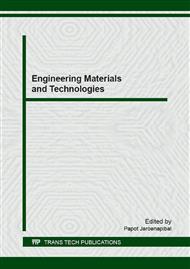[1]
O. Ünal, T. Uygunoğlu, A. Yildiz, Investigation of properties of low-strength lightweight concrete for thermal insulation, Build. Environ. 42 (2007) 584-90.
DOI: 10.1016/j.buildenv.2005.09.024
Google Scholar
[2]
P. Posi, C. Teerachanwit, C. Tanutong, S. Limkamoltip, S. Lertnimoolchai, V. Sata, Lightweight geopolymer concrete containing aggregate from recycle lightweight block, Mater. Design. 52 (2013) 580-6.
DOI: 10.1016/j.matdes.2013.06.001
Google Scholar
[3]
ASTM C 618. Standard Specification for Coal Fly Ash and Raw or Calcined Natural Pozzolan for Use in Concrete. Annual Book of ASTM Standard. (2012).
DOI: 10.1520/c0618-00
Google Scholar
[4]
S. Pangdaeng, T. Phoo-ngernkham, V. Sata, P. Chindaprasirt, Influence of curing conditions on properties of high calcium fly ash geopolymer containing Portland cement as additive. Mater. Design. 53 (2014) 269-74.
DOI: 10.1016/j.matdes.2013.07.018
Google Scholar
[5]
T.N. Phoo, V. Sata, S. Hanjitsuwan, C. Ridtirud, S. Hatanaka, P. Chindaprasirt, High calcium fly ash geopolymer mortar containing Portland cement for use as repair material. Constr. Build. Mater. 98 (2015) 482-8.
DOI: 10.1016/j.conbuildmat.2015.08.139
Google Scholar
[6]
P. Posi, S. Lertnimoolchai, V. Sata, P. Chindaprasirt, Pressed lightweight concrete containing calcined diatomite aggregate, Constr. Build. Mater. 47 (2013) 896-901.
DOI: 10.1016/j.conbuildmat.2013.05.094
Google Scholar
[7]
P. Chindaprasirt, T. Chareerat, V. Sirivivatnanon, Workability and strength of coarse high calcium fly ash geopolymer, Cement Concrete Comp. 29 (2007) 224-9.
DOI: 10.1016/j.cemconcomp.2006.11.002
Google Scholar
[8]
ASTM C138/C138M-14. Standard test of method for unit weight of mortar. Annual Book of ASTM Standard. (2014).
Google Scholar
[9]
ASTM C109/C109M-13. Standard Test Method of Compressive Strength of Hydrualic Cement Mortars (using 2-in. or [50 mm] cube speciments). Annual Book of ASTM Standard. (2013).
DOI: 10.1520/c0109_c0109m-20
Google Scholar
[10]
K. Somna, C. Jaturapitakkul, P. Kajitvichyanukul, P. Chindaprasirt, NaOH-activated ground fly ash geopolymer cured at ambient temperature, Fuel. 90(2011) 2118-24.
DOI: 10.1016/j.fuel.2011.01.018
Google Scholar
[11]
J. Temuujin, A. van Riessen, R. Williams, Influence of calcium compounds on the mechanical properties of fly ash geopolymer pastes, J. Hazard. Mater. 167 (2009) 82-8.
DOI: 10.1016/j.jhazmat.2008.12.121
Google Scholar
[12]
T. Tho-in, V. Sata, P. Chindaprasirt, C. Jaturapitakkul, Pervious high-calcium fly ash geopolymer concrete, Constr. Build. Mater. 30 (2012) 366-71.
DOI: 10.1016/j.conbuildmat.2011.12.028
Google Scholar
[13]
A. Noushini, A. Castel, The effect of heat-curing on transport properties of low-calcium fly ash-based geopolymer concrete, Constr. Build. Mater. 112 (2016) 464-77.
DOI: 10.1016/j.conbuildmat.2016.02.210
Google Scholar
[14]
P. Rovnaník, Effect of curing temperature on the development of hard structure of metakaolin-based geopolymer, Constr Build Mater. 24 (2010) 1176-83.
DOI: 10.1016/j.conbuildmat.2009.12.023
Google Scholar
[15]
M. Soutsos, A.P. Boyle, R. Vinai, A. Hadjierakleous, SJ. Barnett, Factors influencing the compressive strength of fly ash based geopolymers, Constr. Build. Mater. 110 (2016) 355-68.
DOI: 10.1016/j.conbuildmat.2015.11.045
Google Scholar
[16]
S. Alonso, A. Palomo, Calorimetric study of alkaline activation of calcium hydroxide–metakaolin solid mixtures Constr. Build. Mater, 31 (2001) 25-30.
DOI: 10.1016/s0008-8846(00)00435-x
Google Scholar
[17]
S. Hanjitsuwan, S. Hunpratub, P. Thongbai, S. Maensiri, V. Sata, P. Chindaprasirt, Effects of NaOH concentrations on physical and electrical properties of high calcium fly ash geopolymer paste, Cement Concrete Comp. 45 (2014) 9-14.
DOI: 10.1016/j.cemconcomp.2013.09.012
Google Scholar
[18]
U. Rattanasak, P. Chindaprasirt, Influence of NaOH solution on the synthesis of fly ash geopolymer, Miner. Eng. 22 (2009) 1073-8.
DOI: 10.1016/j.mineng.2009.03.022
Google Scholar
[19]
U. Rattanasak, K. Pankhet, P. Chindaprasirt, Effect of chemical admixtures on properties of high-calcium fly ash geopolymer, Inter. J. Min. Met. Mater. 18 (2011) 364-9.
DOI: 10.1007/s12613-011-0448-3
Google Scholar
[20]
W. Lee, V. Deventer JSJ, The effects of inorganic salt contamination on the strength and durability of geopolymers, Colloids Surf. A Physicochem. Eng. Asp. 211 (2002) 115-26.
DOI: 10.1016/s0927-7757(02)00239-x
Google Scholar
[21]
K. Pimraksa, P. Chindaprasirt, A. Rungchet, K. Sagoe-Crentsil, T. Sato, Lightweight geopolymer made of highly porous siliceous materials with various Na2O/Al2O3 and SiO2/Al2O3 ratios, Mat. Sci. Eng. A. 528 (2011) 6616-23.
DOI: 10.1016/j.msea.2011.04.044
Google Scholar


